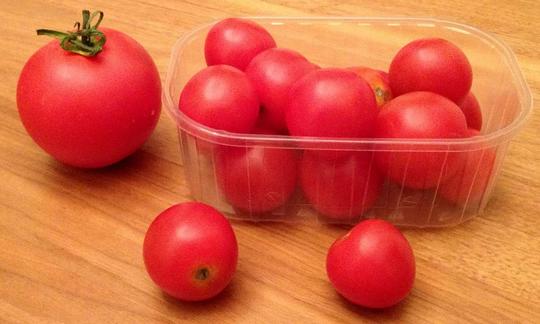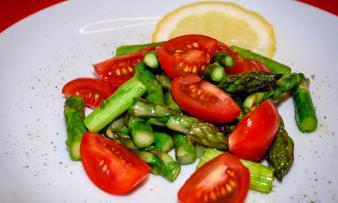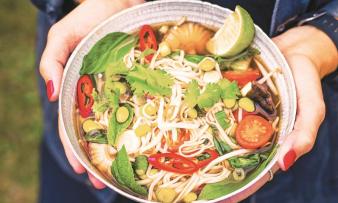Table of contents
Cherry tomatoes ( Solanum lycopersicum var. cerasiforme), also called cherry tomatoes, are a small-fruited variety of tomato. The sweet cherry tomatoes can be used to prepare numerous dishes.
Use in the kitchen
Cherry tomatoes are significantly smaller than "classic" tomatoes. Their size is similar to that of cherries - hence the alternative name cherry tomato. How much does a cherry tomato weigh? The weight of a cherry tomato can vary (around 10-30 g). 10 They come in different varieties, colors (eg red, yellow, orange, green, black) and shapes (eg round, oval). Cherry tomatoes taste very aromatic, fruity and in most cases sweeter than their larger relatives.
There are many uses for cherry tomatoes. In their raw form, you can use them to make delicious salads, e.g. with basil and vegan mozzarella. Tomato salad also goes well with an oil-free salad dressing with walnuts or the oil-free salad sauce with avocado and onion. You can also eat them raw as a snack - or combine them with a vegan dip at a picnic or as an aperitif. They are also particularly suitable for garnishing various dishes, not least raw food creations.
Cooked, these small tomatoes can be used as a side dish or in sauces or soups. Cherry tomatoes are also ideal for all kinds of vegetarian and vegan pasta dishes. You can mix them into spaghetti, add them to a one-pot pasta dish (e.g. with olives) or add them to a pasta salad (e.g. with cucumber). You can also use them to make flans, tarts and galettes - preferably with herbs. Cherry tomatoes braised with garlic or baked in the oven and marinated with rosemary are also recommended. Baked chicory or various curries also taste great with cherry tomatoes.
Here are some recommended vegan recipes with cherry tomatoes:
- Indian tomato soup with cardamom, cumin and turmeric
- Warm asparagus salad with cherry tomatoes
- Vegan Pho with Pak Choi, Edamame, Brown Rice Noodles and Cherry Tomatoes
Vegan recipe for raw cherry tomato and apple soup
Ingredients (for 4 people): 500 g raw cherry tomatoes (organic), 3 apples, 1 onion, 1 clove of garlic, 800 ml water, 50 g nut butter (preferably from macadamia nuts or alternatively cashew butter), 50 ml soy sauce (or less), 2 tbsp lemon juice (raw), (a little salt,)pepper and chopped chives.
Preparation: Wash and halve the raw cherry tomatoes. Wash the apples, quarter them, remove the core and dice the flesh. Peel the onions and garlic cloves and cut into fine pieces. Put the cherry tomatoes, apples, onions and garlic in a blender with water and mix to form a smooth liquid. Add the nut butter, soy sauce and lemon juice and mix to form a creamy soup. You may want to use less soy sauce at first to reduce the salt content. Season with (salt and) pepper. Divide the vegan and raw cherry tomato and apple soup between four bowls and decorate with chives.
Vegan recipes with cherry tomatoes can be found under the note: " Recipes that have the most of this ingredient ".
| Not only vegans or vegetarians should read this: Vegans often eat unhealthily. Avoidable nutritional errors. |
Purchasing - Storage
Cherry tomatoes can be bought in most supermarkets such as Coop, Migros, Denner, Volg, Spar, Aldi, Lidl, Rewe, Edeka, Hofer, Billa etc. Many organic supermarkets (e.g. Alnatura, Denn's Biomarkt) also sell the small tomatoes in organic quality (bio). Cherry tomatoes are in season in Switzerland from April to November. 9 However, they are available all year round. The tastiest ones can be found in late summer. Visit a weekly market - there you will often find a large variety and unusual varieties.
Cherry tomatoes and cocktail tomatoes can easily be confused (see possible confusions below).
The availability of cherry tomatoes varies depending on the size of the store, catchment area, etc. Our recorded food prices for the DA-CH countries can be found above under the ingredient image - and by clicking you can see their development at various suppliers.
Storage tips
Tomatoes don't belong in the fridge. There they not only lose their taste, but also their ingredients. They should be kept at room temperature, so they ripen a little. They can last up to two weeks. Always store tomatoes separately from other vegetables and fruit, as they give off the ripening gas ethene (ethylene), which causes the neighbouring tomatoes to ripen faster and spoil.
Ingredients - Nutritional values - Calories
How many calories does a cherry tomato have? The energy content of a cherry tomato (raw) is 18 kcal/100g. It contains little fat at 0.2 g/100 g. Do cherry tomatoes contain carbohydrates? Carbohydrates (3.9 g/100g) and proteins (0.88 g/100g) are also part of the nutritional values, but only small amounts are present. The cherry tomato consists largely of water (approx. 95%). 2
Do cherry tomatoes contain vitamins? 100 g of raw cherry tomatoes contain 14 mg of vitamin C (17% of the daily requirement). Radishes (15 mg/100g) and fennel (12 mg/100g) provide a similar amount. Yellow bell peppers contain 184 mg/100g, which is more than 13 times as much vitamin C. 2
In addition, 100 g of raw cherry tomatoes contain 237 mg of potassium (12% of the daily requirement). Pomegranates (236 mg/100g) andlettuce (238 mg/100g) have similar contents. Dried herbs and spices contain many times more potassium, such as dried coriander leaves with 4,466 mg/100g (= 44.66 mg/1g). 2 However, it is important to remember that very small amounts of spices and dried herbs are used. Zucchini have almost twice as much potassium as cherry tomatoes, with 459 mg/100g.
The vitamin K content is 7.9 µg/100g (11% of the daily requirement). This content is similar to that in green bell peppers (7.4 µg/100g) andraspberries (7.8 µg/100g). Swiss chard is particularly rich in vitamin K with 830 µg/100g . 2
The complete ingredients of the cherry tomato (raw), the coverage of the daily requirement and comparison values with other ingredients can be found in our nutrient tables. In the article Nutrients explained you will get a detailed insight into the topic.
Health Effects
Are cherry tomatoes healthy? Cherry tomatoes are rich in nutrients and bioactive compounds that are important or beneficial to human health. 5
Secondary plant substances
Many of the health effects of cherry tomatoes can be attributed to the secondary plant substances they contain. Our article on secondary plant substances provides an overview of the classification of substance groups, their occurrence in foods and possible effects on humans.
Cherry tomatoes (like other tomato varieties) contain the following secondary plant substances:
- Isoprenoids: Triterpenes: Steroids (beta-sitosterol, campesterol, stigmasterol, stigmastanol, delta-5-avenasterol, cholestanol, cholesterol, lanost-8-en-3-beta-ol, 24-oxocholesterol); Tetraterpenes: carotenoids (carotenes: lycopene, alpha-carotene, beta-carotene, gamma-carotene, neurospores, phytoene, phytofluene, zeta-carotene; xanthophylls: lutein, neoxanthin, violaxanthin, alpha-cantaxanthin, cryptoxanthin, zeaxanthin, beta-cryptoxanthin) 7,18,20,23
- Alkaloids: Glycoalkaloids: Tomatin 18,19
- Polyphenols: Flavonoids: Flavonols (rutin, quercetin, kaempferol, kaempferol-3-O-rutinoside, myricetin), flavanols (epicatechin, catechin), anthocyanins, flavones (chrysin, luteolin), flavanones (naringenin); Phenolic acids: hydroxybenzoic acids (vanillic acid), hydroxycinnamic acids (chlorogenic acid, caffeic acid, p-coumaric acid, ferulic acid, sinapic acid, cinnamic acid, phloretic acid); Chalcones (naringenin chalcone); Stilbenes (resveratrol); Tannins 7,18,19,20,23
However, it should be noted that the composition of secondary plant substances in (cherry) tomatoes can vary depending on the variety, time of harvest and growing conditions. Therefore, quantities are only of limited use and should only be understood roughly.
Studies show that there are significant differences between the various tomato varieties in terms of the presence and concentration of certain secondary plant substances. For example, the color of the tomatoes influences the composition of the carotenoids they contain. Darker varieties have a higher concentration of carotenoids than lighter varieties, such as yellow tomatoes. 22 Many bioactive substances are also found in greater quantities in the peel and seeds and are particularly concentrated in cherry tomatoes. 2 3
Carotenoids, such as lycopene, which gives tomatoes their red color, contribute significantly to the health benefits of tomatoes. They act as antioxidants and scavenge reactive oxygen species. This prevents damage to DNA by free radicals and protects against chronic inflammation caused by oxidative stress. Carotenoids also block uncontrolled cell growth and thus protect against cancer. 4,5,19,20 Epidemiological studies in humans indicate a protective effect of lycopene on the risk of prostate cancer. Collected data suggest that lycopene is one, but possibly not the only, anti-cancer bioactive compound in tomatoes. In animal models, tomatoes and lycopene also show activity against prostate cancer. However, there are still large gaps in our understanding of the dose-response relationships and molecular mechanisms of action in humans. 24
Research shows that consumption of tomatoes and tomato products can also reduce the risk of obesity, hyperglycemia, hypercholesterolemia and cardiovascular disease. The bioactive ingredients have antioxidant, antiproliferative, antidiabetic and anti-inflammatory effects. These health-promoting properties underline the great potential of tomatoes to prevent or alleviate several chronic degenerative diseases. 7,8,20
A review of recent research shows that the phytochemicals in tomatoes, such as polyphenols and carotenoids, have positive effects on diseases associated with oxidative stress in studies using cell cultures and animal models. Epidemiological studies show a clear link between regular tomato consumption and a reduced risk of cardiovascular disease and cancer. A deficiency in lycopene intake is common in older people and Alzheimer's patients and is strongly predictive of increased mortality and adverse cardiovascular disease markers. Limited evidence from human intervention studies suggests that higher tomato consumption not only improves cardiovascular health indicators but also increases cognitive performance. The review also shows that a diet containing tomatoes appears to be more effective than taking tomato extracts or lycopene as a dietary supplement. 18
In another meta-analysis, scientists analyzed available human studies on the health effects of tomato consumption. From 174 articles searched, they selected 17 articles with 20 different health effects. The researchers found evidence that tomatoes reduce the risk of all-cause mortality, heart disease, stroke, prostate cancer and stomach cancer. Lycopene from food can also reduce the risk of metabolic disorders and male infertility. However, the scientists emphasize that there are still too few studies on humans to draw clear conclusions, as many studies are based on animal or cell models. 21
Dangers - Intolerances - Side effects
Tomatoes (including cherry tomatoes) contain the poisonous glycoalkaloid solanine. Solanine is often used in the advice literature as a collective term for nightshade alkaloids, e.g. α-tomatin in tomatoes or other glycoalkaloids in nightshade plants such as sweet peppers or eggplants. Unripe, green tomatoes have high levels that can be above the toxic limit. In ripe tomatoes, however, the concentration is negligible and therefore there is no risk of poisoning. 3 In the unripe state, the tomatin level is significantly higher at up to 500 mg/kg than in the ripe state (around 5 mg/kg). 17
Some people with sensitive stomachs find cooked tomatoes difficult to digest. 4
Ecological footprint - animal welfare
The CO 2 footprint of cherry tomatoes depends heavily on the cultivation system and regionality. Tomatoes are often grown in greenhouses, especially when the regional climate is too cold or cultivation is not possible seasonally. Heating the greenhouses allows the heat-loving plants to be grown all year round. Alternatively, foil tunnels are used or the tomatoes are grown outdoors, which drastically reduces the amount of energy required. 13 Seasonal, regional vine tomatoes have an average CO 2 footprint of 0.3 kg CO 2 eq/kg, while regional tomatoes from the greenhouse (out of season) have a value of 2.9 kg CO 2 eq/kg. 15 It is therefore best to buy during the season and, if possible, make sure that they are "outdoor tomatoes" from the region. Tomatoes from Switzerland often come from greenhouses, as they need warmth and must be protected from wind and rain. 10
In general, small-fruited tomatoes (e.g. cocktail tomatoes or snack tomatoes - we have not found any details for cherry tomatoes in particular) have a lower yield per m 2 than vine tomatoes for the same expenditure: their carbon footprint is correspondingly larger. In addition, small tomatoes are usually sold in foil-wrapped cardboard or plastic trays. This type of packaging also has a negative impact on the ecological footprint. From an ecological point of view, loose, large tomatoes such as beef tomatoes or plum tomatoes are preferable when shopping. 13
The amount of water required to produce 1 kg of tomatoes also depends on various factors and varies greatly in the literature. The values are between 214 and 1000 liters. 14,15 In contrast to the amount of emissions emitted, the amount of water required for 1 kg of tomatoes from the greenhouse is on average less than for 1 kg of tomatoes from the open field. This is a key factor, especially in dry regions. It is important to mention here that the tomatoes in such glass or plastic greenhouses grow in soilless substrates with nutrient solutions. In foil tunnels or open fields, on the other hand, the tomatoes grow in the soil and receive not only green manure but also organic-mineral fertilization. 16
For detailed explanations of various sustainability indicators (such as ecological footprint, CO2 footprint, water footprint), see our article: What does the ecological footprint mean?
Worldwide occurrence - cultivation
The tomato originally comes from South America and came to Europe via Spain. 9
According to several studies, cherry tomatoes are the result of crossing wild and cultivated tomatoes. 10
Found in the wild
There are wild tomatoes in the tropics and subtropics. These look very diverse - they are usually small, green and sometimes hairy fruits. 1
Possible confusion
Cherry tomatoes are also incorrectly referred to as cocktail tomatoes, but the latter are often elongated and larger. Both varieties are similar, but there is another difference: the cherry tomato is usually a little sweeter in taste. 11
Cultivation - Harvest
Cherry tomatoes are easy to cultivate in the garden or in a pot on the balcony. The plant is easy to care for and usually does not require a stick for support. 9 The harvest can take place earlier than with larger fruits and is practical for home cultivation as the fruits ripen quickly and you always have fresh tomatoes.
The plants are easy to sow yourself. This should be done between February and April. In a sunny and warm place (such as on a sunlit windowsill), the seeds germinate within five to ten days. As soon as the first leaves have formed, the tomato plants should be pricked out. To do this, transplant the individual young plants into their own pots or tubs and water them well. 11 The plants can be placed in their permanent place outside as soon as frost is no longer expected. Cherry tomatoes like it sunny and protected from the weather. They also prefer nutrient-rich, permeable soil with good water storage capacity. 11
It is also relatively easy to care for. Root balls should always be moist, but the leaves should not be moistened, which is why a covered location is ideal. Fertilize every two to three weeks (until the first fruit sets). 11
As soon as the fruit has a strong red color (or yellow or orange, depending on the variety) and a firm skin, the cherry tomatoes are ready to be harvested. When harvesting, be careful not to damage the fruit cap. 11
Further information
The cherry tomato ( Solanum lycopersicum var. cerasiforme) is a variety of the tomato ( Solanum lycopersicum) and belongs to the nightshade family (Solanaceae).
Current breeding methods for new tomato varieties focus on traits such as colour, firmness, flavour and high carotenoid content. These fruit quality traits are more common in traditional varieties than in more modern varieties that are primarily designed for high productivity. There is great potential for including cherry tomatoes in breeding programmes; their genetic diversity and wide geographical range are valued as valuable traits. Desirable traits in cherry tomatoes include disease resistance, soluble solids content, fruit size, flavour, texture, pigmentation and post-harvest quality. 10
Alternative names
The cherry tomato (cherry tomato, also incorrectly written cherry tomato) is also called cherry tomato. In English it is called cherry tomato.
Bibliography - 22 Sources
| 1. | Tomaten-aus-kurpfalz.de Die wilde Tomate – die Wildtomate. |
| 2. | USDA United States Department of Agriculture. |
| 3. | Dgk.de Grüne Tomaten und gekeimte Kartoffeln - das natürliche Gift Solanin. |
| 4. | Pamplona-Roger JD. Heilkräfte der Nahrung. Advent-Verlag: Zürich. 2006: 264-7. |
| 5. | Vats S, Bansal R, Rana N, et al. Unexplored nutritive potential of tomato to combat global malnutrition. Crit Rev Food Sci Nutr. 2022;62(4):1003-1034. |
| 7. | Perveen R, Suleria HAR, Anjum FM, Butt MS, Pasha I, Ahmad S. Tomato (Solanum lycopersicum) carotenoids and lycopenes chemistry; metabolism, absorption, nutrition, and allied health claims--a comprehensive review. Crit Rev Food Sci Nutr. 2015;55(7):919-929. |
| 8. | Cheng HM, Koutsidis G, Lodge JK, Ashor A, Siervo M, Lara J. Tomato and lycopene supplementation and cardiovascular risk factors: A systematic review and meta-analysis. Atherosclerosis. 2017;257:100-108. |
| 9. | Gemuese.ch Cherrytomate. |
| 10. | Ceballos Aguirre N, Vallejo Cabrera FA. Evaluating the fruit production and quality of cherry tomato (Solanum lycopersicum var. cerasiforme). Revista Facultad Nacional de Agronomía Medellín. Juni 2012;65(2):6593–604. |
| 11. | Tomaten.de Cherrytomaten anbauen - Pflanzen, Pflege und die besten Sorten. |
| 13. | IFEU Institut für Energie- und Umweltforschung Heidelberg. Müller-Lindenlauf M, Zipfel G, Rettenmaier N, Gärtner S, Münch J, Paulsch D, Reinhardt G. CO2-Fussabdruck und weitere Umweltwirkungen von Gemüse aus Baden-Württemberg. 2013. |
| 14. | IFEU Institut für Energie- und Umweltforschung Heidelberg. Reinhardt G, Gärtner S, Wagner T. Ökologische Fussabdrücke von Lebensmitteln und Gerichten in Deutschland. Institut für Energie - und Umweltforschung Heidelberg. 2020. |
| 15. | Mekonnen MM, Hoekstra AY. The green, blue and grey water footprint of crops and derived crop products. Hydrol. Earth Syst. Sci. 2011; 15: 1577-1600. |
| 16. | Boulard T, Raeppel C, Brun R, Lecompte F, Hayer F, Carmassi G, Gaillard G. Environmental impact of greenhouse tomato production in France. Agronomy for Sustainable Development 31. 2011; 757-777. |
| 17. | Friedman M. Tomato glycoalkaloids: role in the plant and in the diet. J Agric Food Chem. 1. Oktober 2002;50(21):5751–80. |
| 18. | Ratto F, Franchini F, Musicco M, Caruso G, Di Santo SG. A narrative review on the potential of tomato and lycopene for the prevention of Alzheimer’s disease and other dementias. Critical Reviews in Food Science and Nutrition. 2022;62(18):4970–4981. |
| 19. | Chaudhary P, Sharma A, Singh B, Nagpal AK. Bioactivities of phytochemicals present in tomato. J Food Sci Technol. 2018;55(8):2833–2849. |
| 20. | Ali MY, Sina AAI, Khandker SS, Neesa L, Tanvir EM, Kabir A, et al. Nutritional composition and bioactive compounds in tomatoes and their impact on human health and disease: a review. Foods. 2020;10(1):45. |
| 21. | Li N, Wu X, Zhuang W, Xia L, Chen Y, Wu C, et al. Tomato and lycopene and multiple health outcomes: Umbrella review. Food Chemistry. 2021;343:128396. |
| 22. | Flores P, Sánchez E, Fenoll J, Hellín P. Genotypic variability of carotenoids in traditional tomato cultivars. Food Research International. 2017;100:510–516. |
| 23. | Bianchi AR, Vitale E, Guerretti V, Palumbo G, De Clemente IM, Vitale L, et al. Antioxidant characterization of six tomato cultivars and derived products destined for human consumption. Antioxidants. 2023;12(3):761. |
| 24. | Moran NE, Thomas-Ahner JM, Wan L, Zuniga KE, Erdman JW, Clinton SK. Tomatoes, lycopene, and prostate cancer: what have we learned from experimental models? The Journal of Nutrition. 2022;152(6):1381–1403. |











Comments